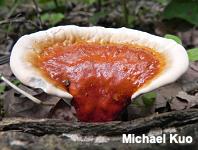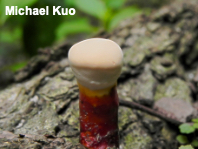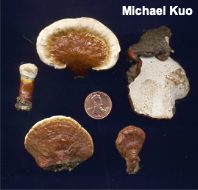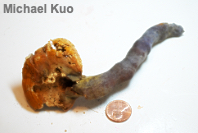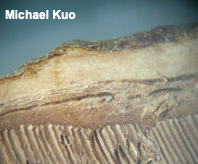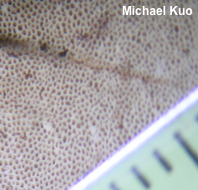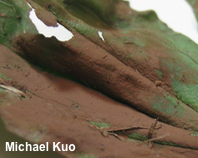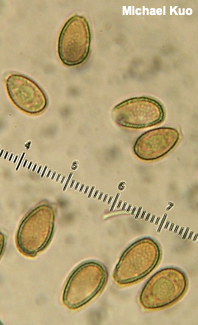| Major Groups > Polypores > Ganoderma > Ganoderma curtisii |

|
[ Basidiomycota > Polyporales > Polyporaceae > Ganoderma . . . ] Ganoderma curtisii by Michael Kuo, 15 May 2024 Originally described from the southeastern United States, Ganoderma curtisii has traditionally been thought of as a southern species. However, recent study of hundreds of North American Ganoderma collections (Loyd and collaborators 2017, 2018) supports the idea that Ganoderma curtisii is widespread east of the Rocky Mountains. Distinguishing features include its gorgeous, lacquered cap and its pale brown flesh, which features melanoid bands but not concentric growth zones (see discussion). It usually (but not always!) features a fairly well-developed lateral stem and, under the microscope, its spores measure 9–11.5 µm long. Ganoderma curtisii meredithiae is identical except that it grows on the wood of pines in the southeastern United States; it was previously recognized as a separate species, but DNA investigation (Loyd and collaborators 2018) failed to support the separation at the species level; see the linked page for further details. Other look-alikes in the southeast are numerous; see the key to Ganoderma for help separating them. Elsewhere in eastern North America, Ganoderma sessile is the principal source of potential confusion; its spores are larger, its flesh does not feature melanoid bands but does feature concentric growth bands, and it is less likely to have a stem. Thanks to Sura Jeselsohn for collecting, documenting, and preserving Ganoderma curtisii for study; her collection is deposited in The Herbarium of Michael Kuo. Description: Ecology: Saprobic and sometimes parasitic; growing alone or in groups on decaying hardwood logs and stumps, or from the wounds of injured, living trees; annual; spring through fall (and over winter in warm climates); widely distributed east of the Rocky Mountains. The illustrated and described collections are from Illinois and New York. Cap: 3–19 cm across; 2–8 cm deep; more or less semicircular in outline, or irregularly kidney-shaped; surface with a lacquered-looking outer crust; zoned with yellow, white, orangish brown, and red when young, maturing to red, brownish red, or reddish brown overall, with or without a few paler (orangish to whitish) zones near the margin; bald. Pore Surface: Whitish to pale brownish when young, becoming medium brown with age; bruising darker brown; with 4–5 tiny, circular pores per mm; tubes 0.5–2 cm deep. Stem: Usually present; lateral and usually at an angle (45–90 degrees) to the cap; bald; lacquered; brownish red to reddish brown. Flesh: Tough but not woody; pale brown (but darker immediately above the tubes); with melanoid bands (see discussion) but without concentric growth zones. Odor and Taste: Not distinctive. Chemical Reactions: KOH instantly black on flesh. Spore Print: Brown. Microscopic Features: Spores 9–12 x 5.5–8 µm including the hyaline vesicular appendix; more or less ellipsoid, with a truncated end; appearing double-walled, with a series of "pillars" between the walls; finely stippled; inamyloid; brown in KOH. Cystidia and setae not found. Hyphal system trimitic. Clamp connections present. REFERENCES: (M. J. Berkeley, 1849) W. A. Murrill, 1908. (Overholts, 1953; Weber & Smith, 1985; Gilbertson & Ryvarden, 1986; Phillips, 1991/2005; Loyd et al., 2017; Woehrel & Light, 2017; Elliott & Stephenson, 2018; Loyd et al., 2018.) Herb. Kuo 04299504, 06271002, 08031601, 10121801. This site contains no information about the edibility or toxicity of mushrooms. |
© MushroomExpert.Com |
|
Cite this page as: Kuo, M. (2024, May). Ganoderma curtisii. Retrieved from the MushroomExpert.Com Web site: http://www.mushroomexpert.com/ganoderma_curtisii.html |
